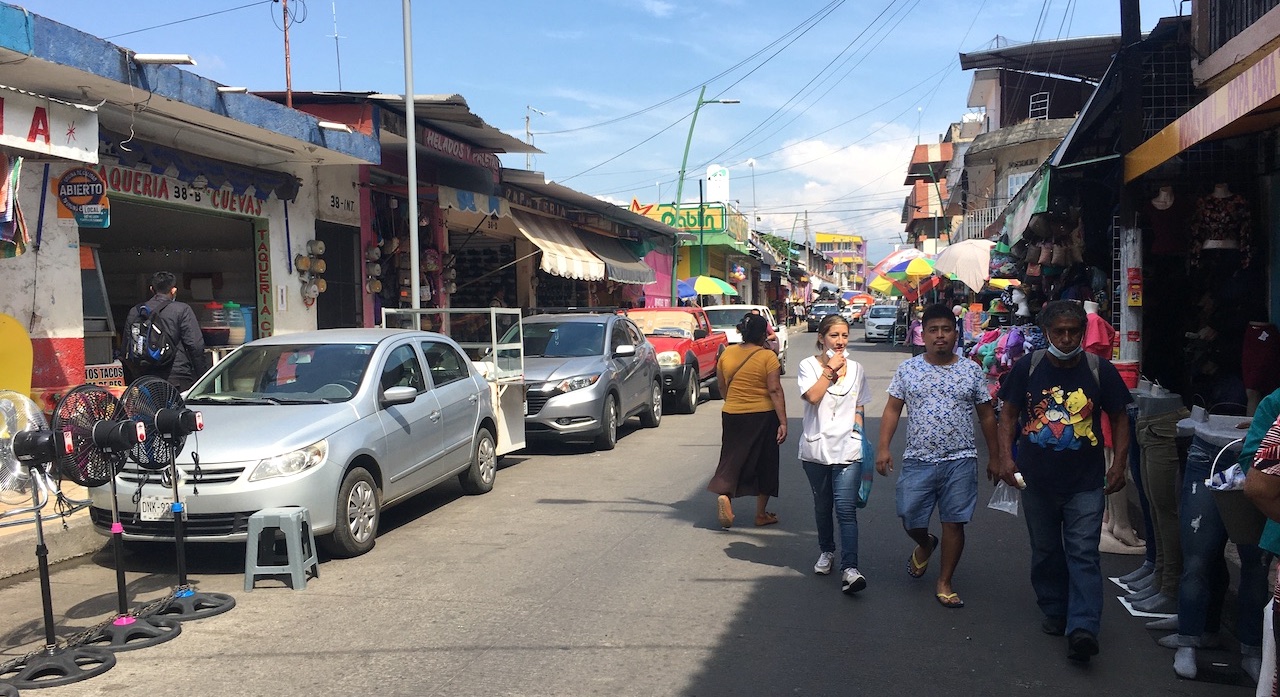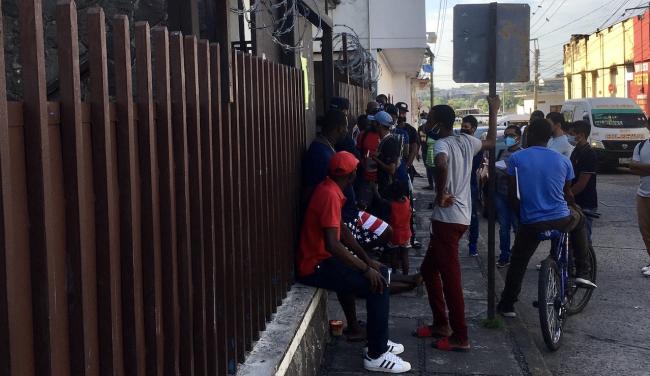For the emigrant, Tapachula is the last stop before continuing down the road and risking everything at the final border. Once in Sonora, Baja California, Chihuahua, Nuevo León or Tamaulipas, northern lands where kidnappers and drug traffickers are a distinct danger, only luck will decide whether or not they make it into the United States.
Although crossing the northern border involves the challenge of surviving some of the most violent areas in Mexico, and the whole world, the route to Tapachula (Chiapas, on the border with Guatemala) is hardly a cakewalk. Those waiting here for immigration status allowing them to continue have already experienced dangers lurking in dense Central American jungles, perilous river crossings, road bandits and other hazards awaiting them in this land, ravaged by violence and destitution.
Thus, the emigrants who reach Tapachula are all, in one way or another, survivors.
Starting points
Javier and his wife were barely 30 when they decided to leave Villa Clara and try their luck at the Spanish consulate in Managua. They thought it was the easiest way to get a visa to travel to Europe and settle there. In the end things did not go as planned, and, after eight months in Nicaragua, they decided that the best thing was to head for the United States.
"Unlike others, we were lucky. I mean, we didn't have any problems. Paying $1,000 each, we joined an immense and secure network of coyotes that brought us to Tapachula in four days. The route was from Nicaragua to Honduras, from there to Guatemala , and then to Tapachula. Except for two river crossings, everything was by road," says Javier, who has already acquired papers certifying him as a "Visitor for humanitarian reasons" in Mexico, and is now considering changing plans.
"Perhaps it's best to stay here. There are many Cubans in Cancun who can give you work. And, the truth is that the United States is no longer that appealing to me, as I’m one of the few that does not have any loved ones there," he explained.
Compared to many Guatemalan, Salvadoran, Honduran, Nicaraguan, Haitian, and African emigrants, Javier and his wife's luck was extraordinary. Among Cubans, however, his is not an isolated case.
There are networks of coyotes (human traffickers) throughout Latin America. The one that took Javier and his wife, for example, starts in Chile, from whence they offer to transport an emigrant to the United States for a fee of $7,000. In this case the trip is by air, with several stops, and entails the complex provisioning of passports fabricated by experts.
Placing yourself in the hands of a large network of coyotes, Javier says, guarantees a fast and safe journey. The full amount is paid up front. Along the way, a different coyote takes clients along parts of the route that he knows like the back of his hand.
"You have to have money and contacts for that. Sometimes one goes with a coyote that already took a relative who now lives in the United States. In my case, it was my brother," says Rodrigo, who also began his route in Nicaragua, then crossed Costa Rica, and is currently waiting at the northern border of Mexico for a permit to enter the United States. His wife and two-year-old son traveled with him.
According to several Cubans interviewed by DIARIO DE CUBA in Tapachula, the first emigrants to cross Central America did so from Guyana, one of the few countries that does not require complicated visa procedures from those who travel from the island. Later, when the Panamanian Government allowed self-employed Cubans to travel to the country with a tourist card for 30 days, this became a popular start of the road towards the United States.
"Starting out in Guyana is dangerous, because the way is longer. You have to go through more countries, and cross Colombia, which is a bad area. And then there is the jungle of the Darien Gap," explains Sergio, who began his migration route in Guyana and has been in Tapachula for four months.
In mid-2019 Panama ceased to be the preferred starting point for Cubans because the government of President Laurentino Cortizo cancelled the issuance of "tourist cards", which benefited immigrants and buyers in the Colón Free Trade Zone alike. Nicaragua, however, welcomed Cubans without requiring visas, thanks to the close political ties between Daniel Ortega's regime and Havana, so the new starting point moved to Managua.
"A lot of people go fast from Nicaragua to Costa Rica. In any case, it is no longer worth staying there to make some money and continue on to the United States. The pandemic has caused everything to shut down, and poverty and violence are on the rise in those countries, which is why more and more Cubans are arriving in Tapachula. Those who have been down there in Nicaragua and Costa Rica for a long time cannot take it anymore and are coming up, en masse," says Javier.
The way
According to several of those interviewed by DIARIO DE CUBA, the best way to cross Central America is without any money on you. But this method is, generally, only available to those who receive support from family members who are already living in the United States, who periodically send them precise amounts of money, in dollars, at points along the route, especially via Western Union.
"There are good and bad coyotes; that is, efficient and lousy ones. The good ones take you by car, or in vans, and they already know the Police. In fact, part of the money you give them is for bribes. The payments given to Border Police are handed over, especially, at dawn, when nobody is watching them," says Rodrigo.
Initially, Rodrigo was lucky. But his good fortune ran out when the coyote told them that the money only covered the trip as far as Guatemala.
"Here you can't start improvising or making demands. First, because it's not your country. Second, because they won't think twice about shooting you right between the eyes. If they scam you, you have to bite your tongue and find another way to continue. In the end, between one thing and the other, things went south for me. The trip with my family ended up costing about $16,000," he told us.
The rest of the journey was tough, and included crossing border areas in the back of a truck with another group of Cubans. Passing through Mexico, he barely stopped on the southern border. He did not even go through Tapachula, as the coyote opted for Tabasco as an alternative route. Then he took him directly to Mexico City, and, from there, with a layover of just a few hours, on to Chihuahua. A definite drawback on this route is that those who take it are in constant danger of being caught by immigration authorities and deported to Cuba.
According to Rodrigo, coyotes operate like many taxis in Cuba: until they get a certain number of clients, they don't depart. This results in delays because, depending on the coyote's experience and connections, the journey does not begin until he musters at least 15 clients. Some, Rodrigo says, wait until they have 60. Thus, Cubans often go in search of others, recommending coyotes.
"The more people, the safer it is. It's not the same if four highway bandits, armed with pistols, go up against 3 migrants, as opposed to 60. I did it alone. It took me almost a year, between when I left Nicaragua and arrived in Tapachula. Along the way, one time they swindled me and took everything I had while holding me at gunpoint. Women who go in small groups are even raped. It's very tough," says Carlos.
Carlos worked for a time in Costa Rica in whatever he could. It wasn't bad at all, he says. He then worked in security, and cleaning floors at a hotel in Honduras for several months. The hotel owner never paid him, as they reached an agreement that he would be compensated by being taken to Tapachula. Once he crossed into Guatemala, however, the man ditched him.
"Then I worked in anything, and made my way, little by little, along with groups of Hondurans and Salvadorans. Once I was in a little truck with twenty-odd people, covered with a tarp; unable to speak, eat, drink water, or move for 24 hours," says Carlos, who is waiting for his papers from Mexico's National Institute of Migration (INM) to continue on to the northern border.
Cuban emigrants' accounts vary in terms of the length of their routes and their conditions. These differences largely depend on the amount of money they have at the outset, the quality of the contacts they were able to make, and, above all, luck.
Despite how grueling their journeys were, in Tapachula everyone talks about them as if they were in a very remote past, which they say, proudly, that they survived.
Note: The sources interviewed for this report asked not to be identified, for safety reasons. Their names were changed.


